| Author |
Message |
    
Ottobotz
| | Posted on Tuesday, January 19, 2010 - 08:48 pm: | 





|
----Redscuell
I think you are on to something here. Where did you get your stacks?
What are they made of?
What is denoid, that you speak off?
Kinda new to all of this, but when there is evidence of more HP/Torque, I am all interested. |
    
Dannybuell
| | Posted on Tuesday, January 19, 2010 - 09:05 pm: | 





|
Ottobot
go to bottom of listings you will see thread named "New 1125r/cr Owner Information"
dannybuell |
    
Blower1
| | Posted on Wednesday, January 20, 2010 - 03:05 am: | 





|
To Redscuell
Sorry about my bad english. Your stacks are fine and worth of the money.
If you read this http://www.honda-tech.com/showthread.php?t=1963201 and this http://www.bgsoflex.com/intakeln.html you maybe understand my point.
Thats why I made two different lengths of stacks to test which performs best to my riding style. |
    
Blake
| | Posted on Wednesday, January 20, 2010 - 04:12 am: | 





|
quote:This engine is more than 10% smaller as the Helicon engine. So its torque gives the solid proof, that the KTM charges substantially better than the Buell.
This problem I would like to understand to find the proper key to solve it.

In the meat of the powerband from 5500 rpm to 10500 rpm, the Buell has significantly more grunt over all, a flatter torque curve.
The Helicon in your plot has a torque curve that remains within 5 N*m of its peak value across a range of 3400 rpm (from 5800 to 9200 rpm). In comparison the KTM torque curve within 5 N*m of peak value spans only 1600 rpm (from 6800 rpm to 8400 rpm). The Buell has a much wider powerband in the high performance portion of the engine's operating range.
That is a result of the cams and their timing and the way the rest of the engine, including exhaust were designed to perform.
Tune the 1125 for peak torque and you'd see it exceed that of the KTM by more than 10%. |
    
Redscuell
| | Posted on Wednesday, January 20, 2010 - 07:24 pm: | 





|
"Sorry about my bad english. Your stacks are fine and worth of the money.
If you read this http://www.honda-tech.com/showthread.php?t=1963201 "
Thanks for that; I'll study that link's printout when I get home!
BTW, my stacks cost just $5 to make, using irrigation / plumbing bits! So, yes, it's fair to say that they're 'worth the money'.  |
    
Ottobotz
| | Posted on Wednesday, January 20, 2010 - 08:32 pm: | 





|
Redscuell-
That is so cool. Thanks a lot for the info., and I am off to the plumbing store. |
    
T_man
| | Posted on Wednesday, January 20, 2010 - 08:35 pm: | 





|
Yeah Red, thanks for all the info! Any tips of what exact 'bits' you used? Like Optimus Prime above I wouldn't mind picking up some plumbing parts for my R either! |
    
Highscore
| | Posted on Friday, January 22, 2010 - 06:13 pm: | 





|
Now the daily routine is back, so it is hard for me to follow the discussion continuously.
When comparing the Helicon engine with the KTM Superduke please keep in mind that this engine has just 990 ccm displacement.
I used this comparison to show the different philosophy of engine set up and tune for the KTM engine, which has a strong "bottom" and a healthy peak torque but for the price of peak power at the end of the range.
The set up philosophy of the Helicon engine is exactly in the opposite way: This is the torque characteristic of a "screamer", focusing the "working area" to the second half of the range by holding the torque here rather constant until.
This is the character of a pure race bike.
I like for myself engines which start earlier with its power production:
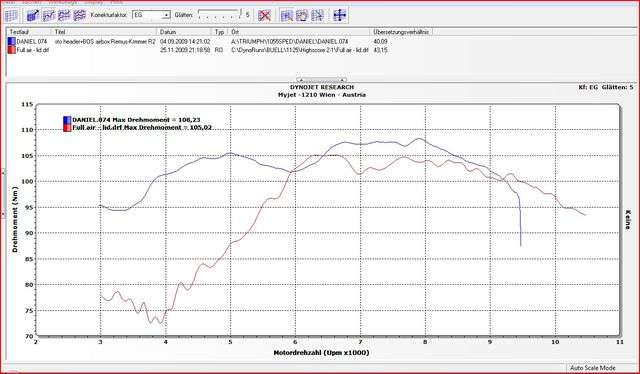
This shows the torque of a Triumph 1050 Speed Triple, like the 1125 and the KTM "mildly tuned" by intake and exhaust mods.
It is not my intention to demonstrate by this comparison how "bad" the Buell is. I only want to figure out, where our bike suffers side by side to its competitors.
For me the Speed Triple is one of the bikes which comes very close with the Buell in its overall character.
This bike is no "racer" it is a "street fighter" (the prototype for this class of motorcycles).
I do not think it is necessary to argue about the quality and performance of this British weapon, it is a legend.
A "street fighter" needs tons of torque´from idle upwards to produce an overwhelming thrust when twisting the throttle.
The torque graph of the 1050 Triumph engine is simply perfect for this duty: from 3000 upwards not matter which gear or engine speed, just hit the throttle and .....
The Helicon engine in its stock tune and set up makes sadly nothing really perfect: It is neither a "racer" (here I am missing at least 20-25 HP at the top) nor a "street fighter" (no growl at the bottom).
May be I am walking over thin ice when I say now, in my understanding the Buell is no race bike, but in fact a street fighter like the Speed Triple. We in Europe are laughing about the fact, there has been established a "special formula" in AMA racing for competing the 1125 Buell with 600ccm racers.
What is wrong with the position of the Buell as a "street fighter"? O.k- there are other bikes better on the track. But this does not mean such a bike is not fast , on the street it can be tremendous fast.
Therefore my aim for Helicon tuning is to trainee its muscles at the bottom of the range. Longer velocity stacks seem to be the proper cure for this goal.
But - @ redscull -the longest stack possible to install into the air box is not necessarily the perfect one for this purpose.
On new and sophisticated engines, forget your experiences with the XB-engine and its single throttle body, things become more complicated. The Helicon engine has real large valves operated by cams without any overlap (for better emissions). Therefore you must tune the intake AND exhaust simultaneously to create the effect you desire.
And since its stock exhaust is so poor,you have to start with the pipe at the Buell.
The stock pipe simply "does nothing" in the middle of the range, for this reason it is furthermore essential to tune the fueling too when analyzing the effects by a mod.
Of course you should see a tendency even with the stock map, but just a simple pipe swap - if you have chosen the right one - boosts mid range power and torque massively: To compensate the better torque by my own pipe design, I had to increase the injector timing around 6000 - the point of the largest increase - for 20% compared to the stock fuel map. And this is a lot.
Highscore
(Message edited by Highscore on January 22, 2010)
(Message edited by Highscore on January 22, 2010) |
    
Highscore
| | Posted on Friday, January 22, 2010 - 07:55 pm: | 





|
My communication here on this board is a little bit fragmented. The logical place to post the pictures following would be a thread,started by Easyrider, I have hijacked, when I have come to this place.
This thread has been started by me and we are talking here about torque-design - my favourite subject. So I think it is o.k, if I post the pics here:
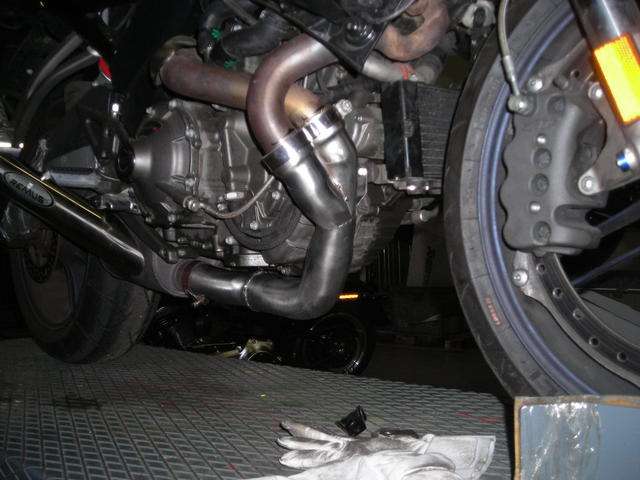
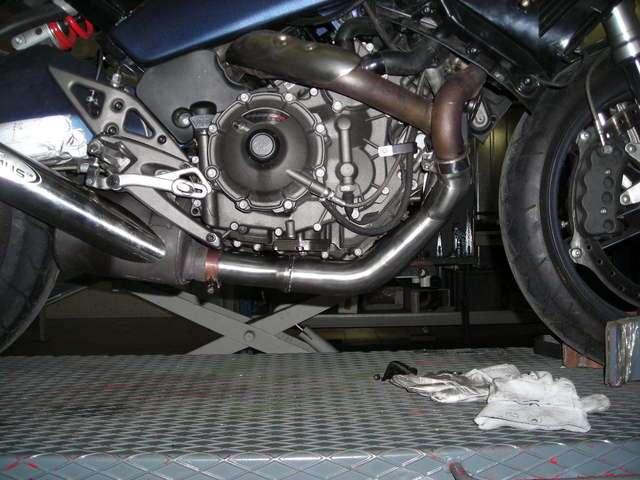
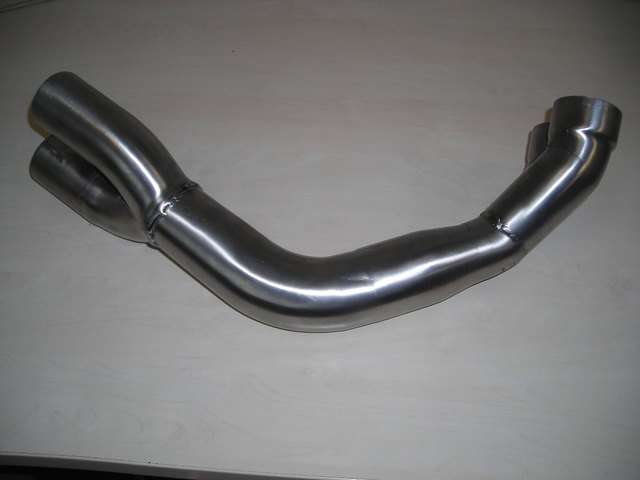
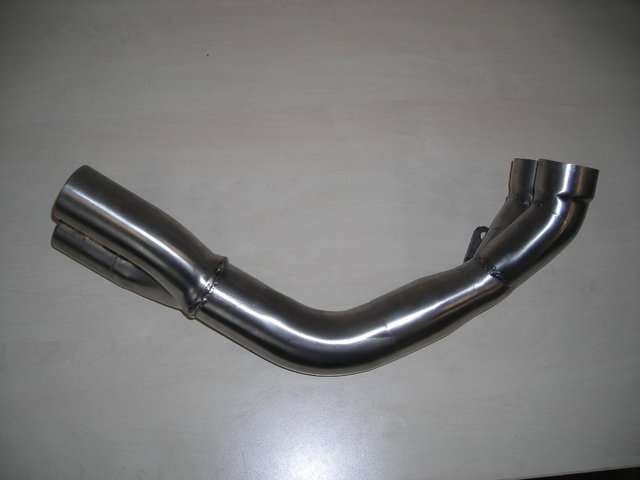
The effect:
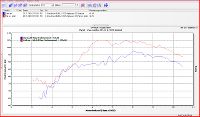

On this graph the fueling is optimized too. But the main effect is the pipe.The proper fuel makes the graph smooth and gives special power around 6 grand, where the pipe shifts up the torque substantially compared stock. But in the other ranges there are just 2-3-4 HP which are released by a perfect A/F-ratio (sorry, the fueling is just the cap stone of a tuning process, this is the gain possible).
This is the new Remus-pipe. @ Easyrider: You are right with your comment about the old design, therefore this new one.
The lay-out is now a 2-1-design with an´additional "working" header length, added to the stock primary headers. This new length creates the new torque in the middle.
The "reference design" during development was a "straight thru"-absorption muffler, a perforated tube with wool around. This is the lay out of a Termingoni or Jardine and some others. It works, but is tremendously loud.
The new Remus design has the same "straight thru"-performance, but with street legal, EC-approved noise.
The layout here is a 2-1-2: The single and common exhaust path branches into two parallel tubes ending side by side in the final reflection-type muffler for this special reason: To avoid any superstition by the muffler disturbing the power production inside of the header.
The final outlet pipe is the EC-approved one. This tube "fine-tunes" the noise. This tube may be replaced by another muffler. Remus has here nice small canisters available in Titan or Carbon for Yamaha R6 or BMW S1000RR.
So it is possible to accent sound and appearance of the Remus exhaust pretty easily.
Highscore
(Message edited by Highscore on January 22, 2010)
(Message edited by Highscore on January 22, 2010)
(Message edited by Highscore on January 22, 2010) |
    
Highscore
| | Posted on Monday, January 25, 2010 - 04:58 pm: | 





|
This comes close to my idea velocity stack regarding length and and it is an example for perfectly shaped intake bell:

This pic shows the "intake shower" of a Buell 1125RR in 185 (rw)HP-Euro-spec.
Here two injectors feed each cylinder, one in the stock position inside the manifold, and an additional one above the velocity stack.
Many modern high performance engines, especially for motorcycles, have this arrangement. The question is, if this second injector is really essential for finding serious power on the Helicon engine.
At least this pic proofs that the stock velocity stacks should and can be improved regarding length and shape.
I discovered this pic here:
http://www.pegasusraceteam.com/html/buell_1190_rr. html
Of course this is just a snap shot of the race bike, but some engine internals are shown too.
Surprising fact: cams are missing in the list of engine mods.
Highscore |
    
Dannybuell
| | Posted on Tuesday, February 02, 2010 - 12:49 am: | 





|
Apparently I want a set of smaller and taller velocity stacks because I will do anything for more low to midrange torque.
Redscuell very clever work!
dannybuell
(Message edited by dannybuell on February 02, 2010) |
    
Redscuell
| | Posted on Tuesday, February 02, 2010 - 01:13 am: | 





|
"But - @ redscull -the longest stack possible to install into the air box is not necessarily the perfect one for this purpose."
If you had read my post more carefully, you'd note that, yes, I did that knowing that it might not be right; the 'void' simply attracted me to try. Yet, in fact, if you look at the map, my simple stacks with the stock muffler make power and torque increases that are worthwhile, so perhaps by lucky coincidence my 4" length is one version of ideal on the 1125R.
"On new and sophisticated engines, forget your experiences with the XB-engine and its single throttle body, things become more complicated. "
Personally I have NO experience with the XB; in my post I was referring to someone else's observation that intake stacks didn't work with what I had to assume (from the testing dates) were on an XB.
"And since its stock exhaust is so poor,you have to start with the pipe at the Buell."
I hate to sound like even BEGINNING to agree with fresno on anything; but my 4 prototypes have given me masses of respect for the oem muffler. I've increased power and torque; and moved torque, by adding a third outlet only. But my efforts to go beyond that addition, have not even measured up to the original. |
    
Jens
| | Posted on Tuesday, February 02, 2010 - 04:04 am: | 





|
Surprising fact: cams are missing in the list of engine mods.
That were just some teaser pics... not to mention as a list of all performance modifications.
Jens |
    
Slypiranna
| | Posted on Wednesday, February 03, 2010 - 10:38 am: | 





|
I'd wager that at least larger valves and head porting are part of that 1190/185 list. This would make sense.
Different cams were rumored over six months ago but I haven't heard a peep since. |
    
Ridenusa4l
| | Posted on Wednesday, February 03, 2010 - 07:00 pm: | 





|
The 1125rr has new cams and larger titanium valves with stiffer springs, to accomidate the 12k redline, i believe that the 1190rr has the same valve train arrangement as the 1125rr, becuase according to the dyno sheet, its redline is hovering around 11,800rpm...
Jake |
|